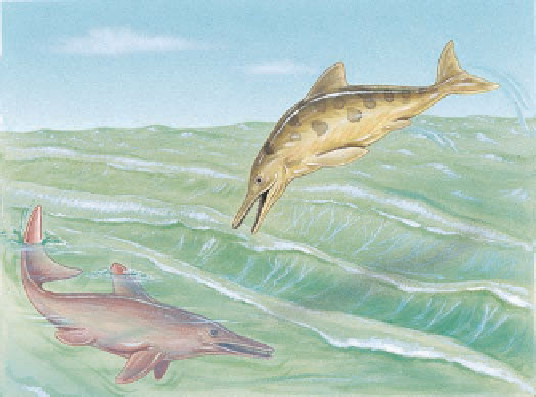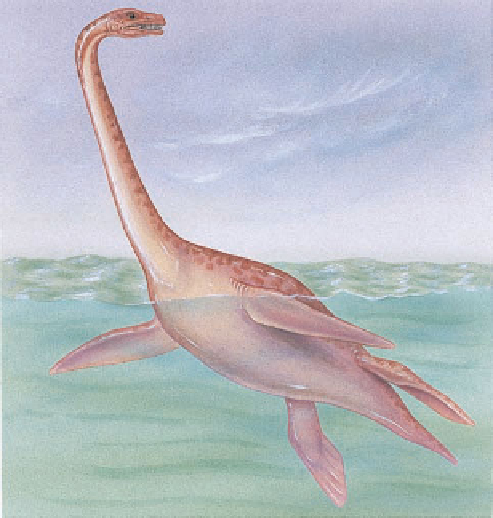Geology Reference
In-Depth Information
◗
Figure 22.27
Mesozoic Marine Reptiles
a
Ichthyosaurs.
b
A long-necked plesiosaur.
hypothesis is probably better supported in that a bipedal
theropod ancestor is reasonable because small theropods had
forelimbs much like those of
Archaeopteryx.
However, from-
the-tree-down has an advantage because takeoff from an el-
evated position is easier, although landing is a challenge.
c
Tylosaurus
, a Late Cretaceous mosasaur, measured up to 9 m long.
With few exceptions, the bones of these birds, known as
Gan-
sus yumenesis
, are much like those of living birds.
Although the fossils of
Archaeopteryx
are significant,
there are not enough of them or of other early birds to re-
solve whether
Archaeopteryx
was the ancestor of today's birds
or an early bird that died out without leaving descendants. Of
course, this does not diminish the fact that
Archaeopteryx
had
both reptile and bird features (recall the concept of
mosaic evo-
lution
from Chapter 18). However, there is another candidate
for earliest bird. Some claim that fossils of two crow-sized indi-
viduals, known as
Protoavis
, from Late Triassic rocks in Texas,
are birds.
Protoavis
does have hollow bones and a wishbone as
today's birds do, but because the specimens are fragmentary
and no feather impressions were found, most paleontologists
think that they are small theropods.
One hypothesis for the origin of bird flight—
from the
ground up
—hold that the ancestors of birds were bipedal,
fl eet-footed ground dwellers that used their wings to leap into
the air, at least for short distances, to catch insects or to es-
cape predators. The
from the trees down
hypothesis holds that
bird ancestors were bipeds that climbed trees and used their
wings for gliding or parachuting. The from-the-ground-up
◗
Figure 22.28
Fossil of
Archaeopteryx
From the Jurassic-age
Solnhofen Limestone of Germany. Notice the feather impressions
on the wings and the long tail. This animal had feathers and a
wishbone, making it a bird, but in most details of its anatomy, it
resembled small theropod dinosaurs. For example, it had reptilian
teeth, claws on its wings, and a long tail—none of which are found
on birds today.







Search WWH ::

Custom Search